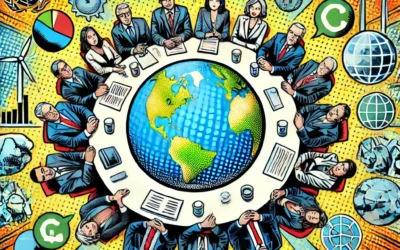Air and Climate: Net Zero Global Target
One of the most urgent and ambitious goals of the global community is to achieve net zero emissions by 2050. This means that the amount of greenhouse gases emitted into the atmosphere is balanced by the amount removed, either by natural or artificial means.
The net zero global target is essential to limit the global warming to 1.5°C above pre-industrial levels, as called for in the Paris Agreement. This would prevent the most catastrophic impacts of climate change on human health, ecosystems, and the economy.
Why is net zero important?
Greenhouse gases, such as carbon dioxide, methane, and nitrous oxide, trap heat in the atmosphere and cause the greenhouse effect, which is the main driver of global warming and climate change. The current concentration of greenhouse gases in the atmosphere is the highest in at least 800,000 years, and it is still rising. As a result, the global average temperature has increased by about 1.1°C since the late 1800s, and it is projected to rise further if emissions are not reduced.
The consequences of global warming are already evident and severe. They include more frequent and intense heat waves, droughts, floods, storms, and wildfires, which threaten lives, livelihoods, and infrastructure. They also include changes in precipitation patterns, melting of glaciers and ice caps, sea level rise, ocean acidification, and loss of biodiversity and ecosystem services. These impacts are expected to worsen with higher levels of warming, and they pose significant risks to food security, water availability, health, peace, and development.
To avoid the worst-case scenarios, the Intergovernmental Panel on Climate Change (IPCC) has warned that global greenhouse gas emissions need to be reduced by 45% by 2030 and reach net zero by 2050, compared to 2010 levels. This would give the world a 50% chance of limiting the global warming to 1.5°C, and a 66% chance of limiting it to below 2°C. Achieving net zero by 2050 is therefore a critical and necessary target for the global community.
How can net zero be achieved?
Transitioning to a net-zero world is a complex and challenging task that requires unprecedented cooperation and action from all sectors and stakeholders. It involves transforming the way we produce and consume energy, transport, food, and goods, as well as enhancing the natural and artificial sinks that remove greenhouse gases from the atmosphere.
The energy sector is the largest source of greenhouse gas emissions, accounting for about three-quarters of the total. Therefore, decarbonizing the energy sector is the key to achieving net zero. This means shifting from fossil fuels, such as coal, oil, and gas, to renewable sources, such as solar, wind, and hydro. It also means improving energy efficiency, electrifying end-use sectors, and deploying low-carbon technologies, such as nuclear, bioenergy, hydrogen, and carbon capture, utilization, and storage.
The transport sector is the second-largest source of greenhouse gas emissions, accounting for about 16% of the total. Decarbonizing the transport sector involves increasing the use of public and active modes of transport, such as buses, trains, bikes, and walking. It also involves switching from internal combustion engines to electric vehicles, powered by renewable energy. It also involves reducing the demand for travel, by promoting teleworking, teleconferencing, and urban planning.
The food sector is the third-largest source of greenhouse gas emissions, accounting for about 13% of the total. Decarbonizing the food sector involves reducing the consumption of animal products, especially red meat and dairy, and increasing the consumption of plant-based foods, such as fruits, vegetables, and grains. It also involves improving the efficiency and sustainability of food production, by adopting practices such as precision agriculture, organic farming, and agroforestry. It also involves reducing food waste, by improving storage, distribution, and consumption.
The goods sector is the fourth-largest source of greenhouse gas emissions, accounting for about 12% of the total. Decarbonizing the goods sector involves increasing the circularity and durability of products, by promoting reuse, repair, recycling, and remanufacturing. It also involves reducing the consumption of material-intensive products, such as clothing, electronics, and plastics, and increasing the consumption of services, such as education, health, and entertainment. It also involves using low-carbon materials, such as wood, bamboo, and bioplastics, and reducing the use of high-carbon materials, such as steel, cement, and aluminum.
Enhancing the sinks that remove greenhouse gases from the atmosphere is also essential to achieve net zero. Natural sinks, such as forests, wetlands, and oceans, absorb about half of the greenhouse gas emissions every year, but they are under threat from human activities, such as deforestation, land degradation, and overfishing. Therefore, protecting and restoring natural sinks is vital to maintain their carbon sequestration capacity and their biodiversity and ecosystem services. Artificial sinks, such as direct air capture and biochar, are emerging technologies that can capture and store greenhouse gases from the ambient air, but they are still at an early stage of development and deployment.
What are the benefits of net zero?
Achieving net zero by 2050 is not only necessary to avoid the worst impacts of climate change, but also beneficial for human health, well-being, and prosperity. According to the International Energy Agency (IEA), reaching net zero by 2050 would prevent 2.5 million premature deaths from air pollution every year, compared to the current policies scenario. It would also create 30 million additional jobs in clean energy and related sectors, and increase the global GDP by 4% by 2050, compared to the current policies scenario.
Reaching net zero by 2050 would also contribute to the achievement of the Sustainable Development Goals (SDGs), a set of 17 global goals that aim to end poverty, protect the planet, and ensure peace and prosperity for all by 2030. For example, reaching net zero by 2050 would help to end hunger and malnutrition, by improving food security and resilience. It would also help to ensure health and well-being, by reducing the exposure to air pollution and extreme weather events. It would also help to provide clean and affordable energy, by expanding the access to renewable sources. It would also help to foster innovation and economic growth, by stimulating the development and diffusion of low-carbon technologies.
Conclusion
The net zero global target is the most urgent and ambitious goal of the global community, as it is the only way to limit the global warming to 1.5°C and prevent the most catastrophic impacts of climate change. Achieving net zero by 2050 requires a complete transformation of how we produce and consume energy, transport, food, and goods, as well as enhancing the natural and artificial sinks that remove greenhouse gases from the atmosphere.
Achieving net zero by 2050 is not only necessary, but also beneficial, as it would improve human health, well-being, and prosperity, as well as contribute to the achievement of the Sustainable Development Goals. The net zero global target is therefore the best and only option for a livable and prosperous future for all.






